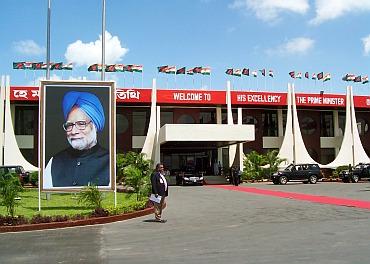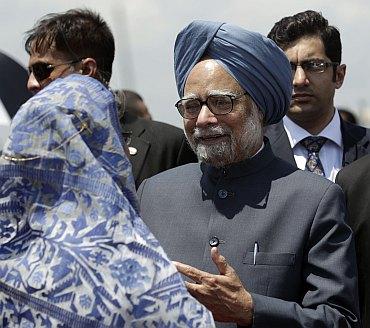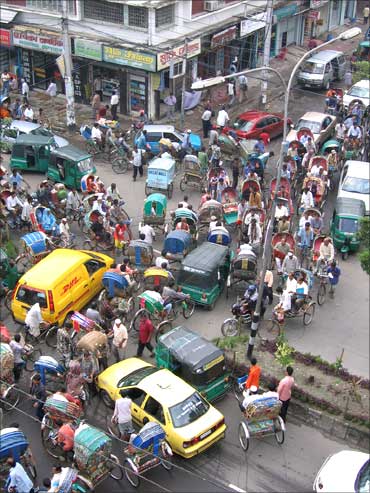
The Bangladeshi capital may at last be up on its feet to embrace much-needed 'urbanisation' with new flyovers and expressways.
In a city where 45,000 people on average live on every square kilometre of space, making it one of the world's most congested, and it often takes two to three hours to negotiate a 20 km distance, even a railway overpass counts as a big urban milestone.
That's exactly how Bangladesh Prime Minister Sheikh Hasina described an 804 metre overpass she opened at Dhaka's Banani railway crossing recently, and one understands why.
The crossing used to be one of the city's worst traffic bottlenecks, with more than 70 trains going past everyday.
It's not anymore.
Another 'milestone' greeted Dhaka's 15.4 million cribbed residents early in the New Year, perhaps with a better claim to be called so.
. . .

A comprehensive redevelopment of the area around Hatirjheel, in the works since December 2008, was formally thrown open to the public, creating a new 10.8 km road link between eastern and western Dhaka and extensive footpaths, lakeside walkways and recreation facilities.
People hailed it as a much-awaited blessing.
Some called it 'heaven'.
Other 'milestones' are on their way, and it looks like Dhaka, one of the least, if not the least, liveable of the world's cities, is at last up on its feet and ready to move.
The 1.7 km Mirpur Airport Road flyover and a link bridge to connect it with the Banani overpass are to be opened in March.
. . .

The 9 km Gulistan-Jatrabari flyover, having four-lane divided carriageways in both directions, is also likely to open around that time, easing up traffic in southern Dhaka.
The 3 km Banani-Kuril flyover could open anytime before then.
And, keeping up the flurry of activities, plans have been approved for a second elevated highway, a 13.32 km link between Shantinagar and Dhaka-Mawa Road.
But the biggest 'milestone' of them all is going to be a mass transit railway that the government has finally decided to build for the city.
It's a $2.7 billion project, at current estimates, and will be financed largely by a $2.1 billion soft loan from the Japan International Cooperation Agency.
. . .

An agreement with JICA was signed last December, raising hopes that this time it's for real.
It's also a step in the right direction.
While flyovers are useful speed-enhancers, their benefits are too local and good only for a handful -- in Dhaka's case, no more than around eight per cent -- of private transport users.
Only a metro network, backed by dedicated bus corridors, can make a real difference and speed up a straggling mega-city like Dhaka.
Tokyo has already given an advance of $133 million to set the ball rolling.
By signing for a metro, the government has also taken a long step towards implementing its strategic transport plan for Dhaka, launched four years ago.
. . .

The plan's stated purpose is to create a network of roads, flyovers, urban railways, bus corridors and water transport systems covering an area of 17,500 sq km, including the neighbouring districts of Narayanganj, Gazipur, Munshiganj, Narsingdi and Manikganj.
Behind this initiative is the realisation that Dhaka's problems can't be effectively solved unless its fringes are tackled at the same time, because that's where most of the urban build-up -- and 'pauperisation' -- takes place.
Four years on, there's reason to be hopeful of the future.
The Banani flyover was completed six months ahead of schedule, something unexpected of a country like Bangladesh -- any south Asian nation for that matter -- where procrastination is a normal part of governance.
. . .

Construction of a much-hyped 17 km elevated expressway from the international airport to Kutubkhali on the Dhaka-Chittagong highway is ready to start this October, after two years of delays over funding and alignment issues.
A 20 km bus corridor from Gazipur to the airport, cutting through Tongi and Uttara, is under-construction with assistance from the Asian Development Bank, and work on a 25 km extension to Sadarghat, with World Bank funding, could begin in a year's time.
As the plans now stand and have been agreed with JICA, the proposed metro will be a 20.1 km elevated track linking the northern suburbs of Uttara with Motijheel, via Mirpur and the city centre.
. . .

The first phase, an 11 km stretch from Pallabi in Mirpur to Sonargaon Hotel, is supposed to be in place by 2019, while the 4.4 km second phase from Sonargaon Hotel to Motijheel, is to follow a year later.
The third and final phase, 4.7 km, from Pallabi to Uttara, is targeted for completion by 2022.
A single metro line, of course, won't solve all Dhaka's problems, with its population threatening to swell to 25 million by 2025, but it's a welcome beginning.
Along with all the flyovers and expressways and bus corridors that are being or proposed to be built in the near future, a metro could indeed transform Dhaka into a visibly different city in the next 10 years, significantly more mobile and liveable than it is now.